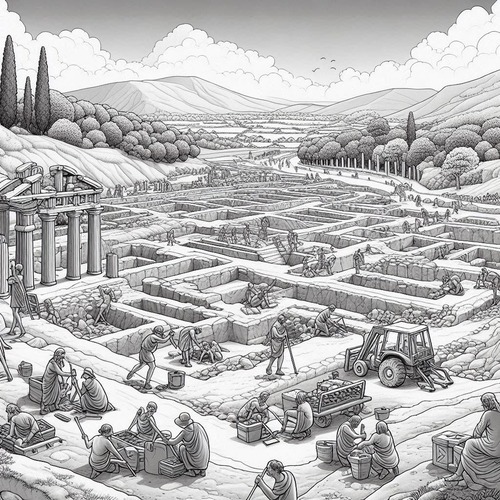Worldwide Ziggurats and Babel: What’s the Connection?
One of the most striking archaeological puzzles confronting historians is the remarkable similarity of pyramid and ziggurat complexes found across ancient civilizations worldwide. From Mesopotamia’s ziggurats to Egypt’s pyramids, from Central America’s temple pyramids to Southeast Asia’s stepped monuments, these structures share uncanny architectural and religious parallels—despite being built by supposedly unconnected cultures separated by vast distances and time periods.
Does this global phenomenon provide compelling archaeological support for the Bible’s account of the Tower of Babel found in Genesis 11?
THE HABERMEHL HYPOTHESIS: A MODERN APOLOGETIC FRAMEWORK
While various Christian scholars have noted connections between ancient ziggurats and the Babel account, researcher Anne Habermehl developed the most comprehensive modern argument linking worldwide ziggurat/pyramid complexes to the biblical Babel narrative. Habermehl, an independent researcher specialising in biblical subjects, argues the city that accompanied the Babel tower was most likely composed of temples and various other religious structures, with the tower itself being a ziggurat (stepped pyramid).
The many known ziggurats (stepped pyramids) around the world greatly resemble each other, even though the peoples that built them were from widely different cultures. This would appear to indicate a common origin for their design. Habermehl contends all these ziggurats are patterned after the Tower of Babel that was built in Shinar soon after the worldwide Flood.
THE BIBLICAL FOUNDATION
The Genesis account describes humanity’s post-flood migration to the plain of Shinar, where they attempted to build “a city and a tower whose top is in the heavens” to prevent their dispersion (Genesis 11:4). God’s intervention scattered the people and confused their language, ending the unified construction project.
Habermehl’s thesis suggests that after the Babel dispersion, people built ziggurats wherever they settled, smaller ones at first, and then larger ones as their population and resources increased. This explains why similar architectural forms appear globally among cultures with no apparent historical contact.
ARCHAEOLOGICAL EVIDENCE SUPPORTING THE THEORY
The archaeological record reveals several compelling patterns that align with the Babel hypothesis:
- Structural Similarities: Ancient ziggurats and pyramids worldwide share distinctive features – stepped construction, religious purposes, astronomical alignments, and association with temple complexes. These similarities transcend cultural boundaries in ways that parallel evolutionary patterns suggest common ancestry rather than independent development.
- Geographic Distribution: The global distribution of these monuments corresponds remarkably well with the migration patterns one would expect following a dispersion event from Mesopotamia. As populations spread from the Middle East, similar monumental architecture appears along likely migration routes.
- Religious Parallels: Perhaps most significantly, these structures consistently served religious functions involving attempts to bridge earth and heaven – precisely the spiritual rebellion described in the Babel account. The recurring theme of reaching toward the divine through monumental architecture suggests a shared cultural memory of the original Babel project.
- Timeline Consideration: Archaeological evidence suggests such ziggurats must have been built no later than 2,400 BC, placing them within the biblical timeframe for post-flood civilisation development.
SCEPTIC OBJECTIONS
Critics raise several objections to the Babel-ziggurat connection:
Multiple Language Origins: Some argue there were many languages in the world before the Tower was built. They claim the biblical narrative came from oral traditions only written down around 800 BC and therefore cannot be considered accurate. However, this objection assumes evolutionary models of language development and dismisses the possibility of divinely-revealed historical memory preserved in Scripture.
Cultural Diffusion: Secular archaeologists typically attribute similarities to cultural diffusion through trade and migration. While diffusion explains some similarities, it cannot adequately account for the specific religious symbolism and architectural features that appear simultaneously across widely separated regions with no evidence of contact.
Independent Development: Some scholars suggest pyramid-building represents a natural architectural evolution that different cultures independently discovered. However, the specific combination of features—stepped construction, religious purpose, astronomical orientation, and heaven-reaching symbolism—represents too specific a pattern for coincidental independent development.
THE CHRISTIAN COUNTERARGUMENT
The Babel hypothesis provides a more elegant and comprehensive explanation for the archaeological evidence than secular alternatives:
- Unified Origin: Rather than requiring multiple independent inventions of similar complex architectural and religious concepts, the Babel model provides a single, historically grounded origin point that naturally explains global distribution.
- Religious Coherence: The consistent heaven-reaching religious symbolism across cultures finds its most logical explanation in a shared cultural memory of the original Babel rebellion against divine authority.
- Archaeological Timing: The chronological appearance of these monuments aligns well with biblical timelines for post-flood civilization development and human dispersion.
- Cultural Memory: Many ancient cultures preserve flood accounts and tower-building legends that remarkably parallel the biblical narrative, suggesting authentic historical memory rather than borrowed mythology.
WORLDWIDE ZIGGURATS AND BABEL: CONTEMPORARY IMPLICATIONS
The global pyramid complexes serve as witnesses to the truth of the Bible account and constitute compelling archaeological support for the authenticity of the biblical story of Babel. Rather than viewing ancient monuments as evidence of human religious evolution, we can recognise them as testimonies to humanity’s shared history and God’s sovereign intervention in human affairs.
The scattered ziggurats and pyramids worldwide may be viewed as stone witnesses to the reality of Babel. They may thus be reminders to us that human attempts to reach heaven through works ultimately fail, pointing us toward the true bridge between earth and heaven—as found in Jesus Christ. The global distribution of these monuments, rather than contradicting biblical history, may be viewed as compelling evidence for the historical accuracy of Genesis.
WORLDWIDE ZIGGURATS AND BABEL: RELATED FAQs
How does the Great Pyramid of Giza specifically connect to the Babel account? The Great Pyramid’s precise astronomical alignments and its original smooth limestone casing that would have gleamed like a beacon “reaching toward heaven” mirror the Babel builders’ ambitions. Its location at the geographical centre of the world’s landmasses suggests the builders were attempting to create a new “centre of the world” after their dispersal from Shinar. The pyramid’s internal chambers and passages, particularly the ascending passages leading to the King’s Chamber, symbolically represent humanity’s attempt to ascend to the divine realm through architectural achievement.
- What specific features do Central American pyramids share with the biblical Babel description? The stepped pyramids at Teotihuacan, Chichen Itza, and other Mesoamerican sites feature temple structures at their summits designed for communication with the heavens—precisely matching Babel’s purpose as a tower “whose top is in the heavens.” These pyramids served as cosmic mountains connecting earth and sky, with priests ascending the steps in ritual re-enactment of reaching toward God. The Pyramid of the Sun at Teotihuacan, like many others, was built with precisely 365 steps, showing the same astronomical obsessions that likely characterised the original Babel project.
- How do Southeast Asian temple complexes like Angkor Wat support the Babel connection? Angkor Wat was designed as a replica of Mount Meru, the cosmic mountain that Hindu-Buddhist cosmology describes as the centre of the universe—the same “navel of the world” concept behind Babel. Its five central towers represent the peaks of Mount Meru, symbolically recreating the divine realm on earth. The temple’s massive scale and its function as a bridge between earthly and heavenly realms directly parallel the Babel builders’ stated goal of making “a name for ourselves” and preventing their scattering across the earth.
What role did the Sumerian ziggurats play as potential “copies” of the original Babel tower? The ziggurats at Ur, Babylon (Etemenanki), and other Mesopotamian cities were likely built by descendants who remained in the region after the Babel dispersion, making them the closest architectural relatives to the original tower. These structures retained the clearest memory of Babel’s design: stepped construction, temple crowns, and names like “House of the Foundation of Heaven and Earth.” The Babylonian ziggurat Etemenanki, possibly built on Babel’s original site, maintained the tradition of using the tower to “reach heaven” through ritual ascension ceremonies.
- How do the names of these monuments support the Babel dispersion theory linguistically? Many ancient pyramid and ziggurat complexes retain variations of words meaning “tower,” “mountain of God,” or “stairway to heaven” across unrelated language families. The Egyptian word “pyr-amid” relates to fire/light reaching upward, while Mesopotamian “ziggurat” means “to build high.” Mayan “ku-kul-kan” (feathered serpent) and other Central American pyramid names often invoke sky-serpent or sky-god concepts, suggesting scattered peoples retained linguistic memories of the original tower’s heaven-reaching purpose despite developing entirely different languages.
- What archaeological evidence suggests these monuments were built within the biblical timeframe for post-flood civilization? Archaeological dating places the earliest ziggurats in Mesopotamia around 2400-2100 BC, followed by Egyptian pyramids around 2600-2500 BC, which aligns remarkably well with biblical chronology placing Babel approximately 2250-2200 BC. The spread of similar monumental architecture eastward to the Indus Valley (2500-2000 BC) and eventually to the Americas (later waves) follows expected migration patterns from a Mesopotamian origin point. Carbon-14 dating of organic materials from these sites consistently supports this chronological framework rather than the millions-of-years evolutionary timeline.
Why don’t secular archaeologists accept the Babel connection despite these obvious similarities? Secular archaeology is constrained by naturalistic assumptions that require explaining similarities through gradual cultural diffusion or independent invention, even when the evidence points to sudden appearance and common origin. The religious implications of accepting a biblical explanation conflict with evolutionary paradigms that dominate academic archaeology. Additionally, acknowledging divine intervention in human history (language confusion and scattering) challenges the materialistic worldview that underlies most archaeological interpretation, leading scholars to prefer complex, multi-step explanations over the simpler biblical account that better fits the evidence.
WORLDWIDE ZIGGURATS AND BABEL: OUR RELATED POSTS
Editor’s Pick

Sacred Fury: What Christ’s Temple Cleansing Truly Means
Mark 11 records the crack of a handmade whip that echoed through the temple corridors. Tables crashed to the ground, [...]

Did Jesus Cleanse the Temple Twice?
OR DID JOHN DISAGREE WITH THE SYNOPTICS ON TIMING? One of sceptics’ favourite "gotcha" questions targets what they see as [...]

Self-Authentication: Why Scripture Doesn’t Need External Validation
"How can the Bible prove itself? Isn't that circular reasoning?" This objection echoes through university classrooms, coffee shop discussions, and [...]

The Racial Diversity Question: Does the Bible Have Answers?
Walk into any bustling metropolis today and you'll likely witness humanity's breathtaking diversity—the deep ebony skin of a Sudanese family, [...]

Do Christians Need Holy Shrines? Why the Reformed Answer Is No
Walk into a medieval cathedral and you'll encounter ornate shrines, gilded reliquaries, and designated "holy places" where pilgrims gather to [...]

If God Is Sovereign, Why Bother Praying?
DOESN’T DIVINE SOVEREIGNTY OBVIATE PRAYER? **Editor’s Note: This post is part of our series, ‘Satan’s Lies: Common Deceptions in the [...]

I Want To Believe, But Can’t: What Do I Do?
"I want to believe in God. I really do. But I just can't seem to make it happen. I've tried [...]

BC 1446 or 1250: When Did the Exodus Really Happen?
WHY REFORMED SCHOLARS SUPPORT THE EARLY DATE Many a critic makes the claim: “Archaeology has disproven the biblical account [...]

Does God Know the Future? All of It, Perfectly?
Think about this: our prayers tell on us. Every time we ask God for something, we’re confessing—often without realising it—what [...]

Can Christian Couples Choose Permanent Birth Control?
Consider Sarah, whose fourth pregnancy nearly killed her due to severe pre-eclampsia, leaving her hospitalised for months. Or David and [...]





